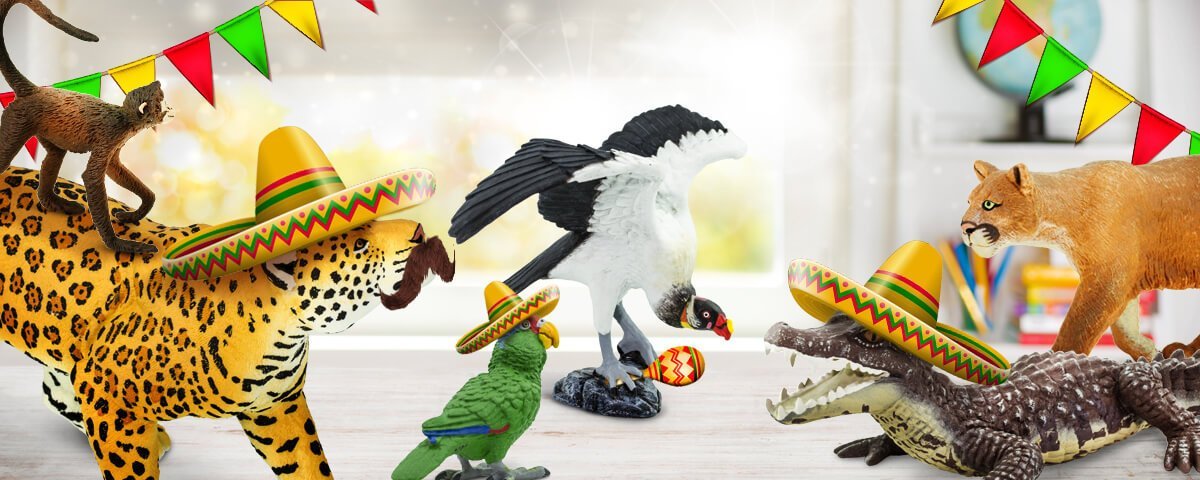
Learn About Cinco de Mayo Using Safari's Animal Toys!
The 5th of May is Cinco de Mayo, a holiday to commemorate the Mexican Army’s defeat of the much larger French Army during the Battle of Puebla on May 5th, 1862. For many people these days, the holiday normally means getting together at their favorite Mexican restaurant, or throwing a party with a Mexican theme. However, in 2020 with social distancing in full effect due to the global coronavirus pandemic, folks are probably gearing up for a much more subdued Cinco de Mayo celebration.
Safari Ltd's Animal Toys Found in Mexico
At Safari Ltd, we thought this might be a great time to learn about some of the animals of Mexico using our figurines. Mexico’s mix of temperate and tropical climate make it a biological hot spot, and it ranks fourth in the entire world in biodiversity. It is home to over 200,000 uniques, a whopping 10% of global biodiversity. So let’s take a look at just some of the incredible animals that can be found in Mexico…
Jaguar
The only true “big cat” in the Americas, the jaguar counts among its close relatives the lion, the tiger, and the similar-looking leopard. How can you tell the two apart? Check out our Which Cat is That blog for more info on spotting the differences.
Jaguars once roamed the entirety of Mexico and much of South America, and even had a pretty good foothold in the southwestern United States. Unfortunately, today much of their range has been greatly reduced and they are considered a “near threatened” species.
Like their cousins the leopards, jaguars are yellow-orange and covered with clusters of black spots known as “rosettes”. Each rosette of a jaguar features a ring of spots around a central spot, while the leopard’s rosettes lack the spot in the middle. Both leopards and jaguars can be “melanistic”, meaning they produce so much of the pigment melanin that the fur appears entirely black. In both jaguars and leopards these dark colored cats are known as “black panthers”.
Jaguars live in many different habitats, including rainforests, open wetlands, and grassland. However, it very much prefers to be near water. Their spotted pattern is thought to help conceal them amongst the shadows of leaves in the forest. The jaguar is an apex predator that eats just about anything – armadillos, deer, fish, caimans, anteaters and more.
Mountain Lion (Puma)
While the jaguar is the only true “big cat” in the Americas, it’s not the only large feline to be found in the New World. While the mountain lion (or cougar, or puma) is often associated with the western United States and Canada, it is also found throughout Central and South America, including almost the entirety of Mexico.
Though it can grow almost 8 feet long, the mountain lion (known as puma in much of the Latin American world) is not considered a true “big cat” for a couple of reasons. First, it is not a member of the genus Panthera, which includes the lion, tiger, jaguar, and leopard, as well as the smaller snow leopard. Second, it cannot roar. Instead, it produces a number of other sounds, including growls, hisses, and a distinctive scream.
Pumas, like other wild cats, are carnivores and expert hunters, taking a wide range of prey. In their northern range, their prey tends to be larger, including deer, elk, pronghorn antelope and mountain goats. However, in their southern range, including Mexico, smaller prey is usually preferred, such as capybaras (a large type or rodent), birds, and reptiles.
This is because in the southern part of their range, the puma’s territory overlaps with the jaguar’s, and the larger cat tends to take the larger prey animals. Without such feline competition in the north, the mountain lion can pursue bigger animals.
Vaquita Porpoise
The vaquita porpoise is one of the most endangered animals in the world. It is one of the smallest and rarest of the cetaceans (the group that includes whales, dolphins and porpoises). It is found only in the northernmost section of the Gulf of California, a large sea that separates the Baja California peninsula from the rest of mainland Mexico.
In the small northern tip of this body of water, there are currently thought to be just about a dozen vaquita porpoises left. Gill nets placed in the water by fisherman, hoping to catch a large, valuable fish called the totoaba, often mistakenly ensnare vaquita and cause them to drown. Despite being made illegal, these nets continue to pose a serious threat to the porpoise.
Vaquita means “little cow” in Spanish. They only grow to around five feet long, making them the smallest living member of the porpoise family. It is an elusive species, rarely seen except when it occasionally surfaces to breathe. It is shy and prefers to avoid humans. It feeds on fish, squid, and crustaceans (such as crabs).
Many efforts are underway to try to save this rare and unique porpoise, though some scientists fear it may be too late. If you’d like to learn more about how scientists and activists are trying to save the vaquita, check out our blog – “Can We Save the Vaquita?”
Manatee
Another marine mammal native to Mexico is the manatee. The species that is found in Mexican waters is the West Indian manatee, the same manatee species found along the eastern coast of the United States, as well as in Cuba and the Caribbean. In Mexico, the manatee can be found on the southeastern coast, in particular around the Yucatan Peninsula and the Isthmus of Tehauntepec.
Manatees, also known as “sea cows” are members of a group called Sirenians. Like whales, they are marine mammals who have evolved flippers and tails instead of hands and feet. Also like whales, they are protected by a layer of fat called blubber which gives them a rotund appearance. Despite these similarities, they are not closely related to whales, and the closest living relatives of manatees are believed to be elephants.
Manatees are slow moving creatures that like to linger near the water’s surface, munching on water plants. Because of this, they are especially vulnerable to strikes from boat propellers.
Spider Monkey
Seven species of spider monkey inhabit the tropical forests of Central and South America. Southern Mexico is home to Geoffroy’s spider monkey, and its two subspecies, the Mexican spider monkey and the Yucatan spider monkey.
All spider monkey species are threatened. Geoffroy’s in particular is endangered, and the Mexican subspecies is classified as critically endangered. Since the monkeys need large areas of forest to live in, destruction of their tropical habitat causes lasting damage to their populations.
Spider monkeys are named for their thin, long limbs which give them a spider-like appearance. They spend most of their time in trees, in groups as small as 15 or as large as 40, and use their long arms, legs and tail to help them to swing effortlessly from branch to branch.
Spider monkeys eat mostly fruits and nuts, thought they are not above eating bugs and the occasional bird egg if their preferred foods are hard to find.
Howler Monkey
{{cta('2b476229-9784-4342-807d-b70c3126182c')}}
Howler monkeys are closely related to spider monkeys; both are in the family Atelidae. Species that call Mexico home include the mantled howler (particularly its subspecies, the Mexican howler), and the Guatemalan black howler. Both are found in southern Mexico, in and around the Yucatan peninsula.
Howler monkeys are appropriately named for their calls – haunting howls that can be heard over three miles away! Like spider monkeys, they use their long limbs and tails to move expertly through the trees of tropical forests, sometimes even using their tails to support their entire body!
Due to deforestation and habitat destruction, both species of howler monkeys native to Mexico are endangered, the Mexican howler critically so. Howlers have a grumpy disposition compared to most other monkeys and don’t do particularly well in captivity; however they are still sometimes captured for sale as pets or to zoos.
Green Cheeked Amazon Parrot
Heading back up to northeastern Mexico, you might encounter the green-cheeked amazon parrot, also known as the Mexican red-headed parrot. In addition to its range in Mexico, this species is also found in a very small area on the southernmost tip of Texas, making it the only living parrot species truly native to the United States.
They are usually found in lowland forests, but adapt well to urban environments. Nevertheless, they are endangered, and their numbers are sadly declining. Part of this is due to habitat destruction, but illegal capture for the pet trade is another major factor.
Due to the striking green and red coloration, coupled with their intelligent, affectionate nature, these parrots are popular and sought after as pets. However, with the wild bird population thought to number in the low thousands, the black market trade in green-cheeked amazons is a serious threat to the continued survival of the species.
King Vulture
Heading down south again, we’ll find another bird with striking coloration. Found throughout much of Central and South America, the king vulture is encountered in Mexico along the southern coastal areas, as well as the Yucatan Peninsula.
Unlike most vultures, which tend to be drab and somewhat ghoulish looking, the king vulture displays striking white and black feathers, as well as a veritable rainbow of colors on its bald head. The fleshy folds of the vulture’s head can display blue, red, orange, purple and yellow. The most vibrant area is the large orange growth around the beak, called a “caruncle”.
Not counting the two types of condors (Andean and California), the king vulture is the largest vulture of the Americas, with a wingspan of up to seven feet. Like other vultlures, the king vulture is mostly a scavenger, feeding on dead animals. It locates its food using vision, though it may also use its sense of smell. Typically though, it follows smaller species of vulture, who have a better sense of smell, to its next meal.
Caiman
Lastly, we come to the caiman. Caimans are a group of reptiles closely related to the alligator. Most of the six living species of caiman are found entirely in South America, but one species is known to inhabit Central America, including Mexico – the spectacled caiman.
Caiman are typically smaller than most of their alligator and crocodile relatives, rarely growing longer than ten feet. While that may seem large, remember that many crocs and gators can grow upwards of 15 feet or more, and the saltwater crocodile can grow more than 20 feet long.
The spectacled caiman is named for a ridge that grows in front of its eyes, which resembles a small pair of glasses or spectacles. In Mexico it is found mostly in the Isthmus of Tehauntepec, a stretch of land between the Gulf of Mexico and the Pacific Ocean, which connects the Yucatan Peninsula with the rest of Mexico’s mainland.
Spectacled caimans are known to eat just about anything they can snatch, including crabs, fish, insects, frogs, small mammals, reptiles, birds, and snails. It is a generalist species, which means it is able to change its habits and prey preference according to what is most available in a given area.
The spectacled caiman has the widest range of any caiman species, and is currently considered a “least concern” species. In the 1980s, it was threatened, due to being hunted for its skin. However, in more modern times it actually benefits from other crocodile species being overhunted by humans, as it frequently moves into territory and habitat that other related species have been exterminated from.
Hopefully you have enjoyed this educational excursion to learn about some of the unique and diverse animals found in Mexico on this Cinco de Mayo. When celebrating Mexico, remember to celebrate the amazing creatures - many of which need our help to avoid extinction – that call Mexico home.








 Facebook
Facebook
 Twitter
Twitter
 Instagram
Instagram
